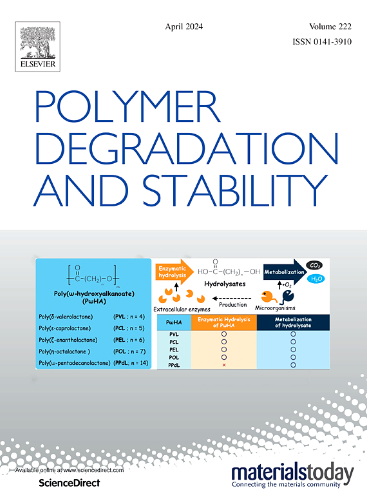In vitro temperature-dependent degradation of polylactic acid: Experimental characterization and neural network-based prediction
IF 6.3
2区 化学
Q1 POLYMER SCIENCE
引用次数: 0
Abstract
To ensure the reliable use of polylactic acid (PLA) as a medical polymer, it is essential to develop a model that can accurately assess the degradation of its mechanical properties under in vitro conditions. In this study, PLA was immersed in phosphate buffered saline at 37 °C to investigate its degradation behavior. A marked decline in tensile strength was observed following an induction period, with surface analysis revealing that diffusion-limited hydrolysis (DLH) characterized by the formation of hydrolysis-induced micro-pits and cracks was the primary degradation mechanism. Chain scission and crystallization behavior resulting from hydrolysis were systematically examined. Using experimental data obtained at elevated temperatures (50, 60, and 70 °C), crystallization kinetics were modeled using the Avrami equation, enabling the development of a predictive relationship between tensile strength and crystallinity. Furthermore, an artificial neural network was employed to construct a model capable of accurately predicting tensile strength across a range of temperatures and exposure durations, thereby enhancing the reliability of PLA for in vitro applications.

体外温度依赖性聚乳酸降解:实验表征和基于神经网络的预测
为了确保聚乳酸(PLA)作为医用聚合物的可靠使用,必须开发一种能够准确评估其在体外条件下力学性能降解的模型。在本研究中,PLA在37°C的磷酸盐缓冲盐水中浸泡,以研究其降解行为。诱导期后,拉伸强度明显下降,表面分析表明,扩散限制水解(DLH)是主要的降解机制,其特征是形成水解诱导的微坑和裂纹。系统地考察了水解引起的链裂和结晶行为。利用在高温(50,60和70°C)下获得的实验数据,使用Avrami方程对结晶动力学进行建模,从而建立了抗拉强度和结晶度之间的预测关系。此外,利用人工神经网络构建了一个模型,该模型能够在一定温度和暴露时间范围内准确预测PLA的拉伸强度,从而提高PLA在体外应用中的可靠性。
本文章由计算机程序翻译,如有差异,请以英文原文为准。
求助全文
约1分钟内获得全文
求助全文
来源期刊

Polymer Degradation and Stability
化学-高分子科学
CiteScore
10.10
自引率
10.20%
发文量
325
审稿时长
23 days
期刊介绍:
Polymer Degradation and Stability deals with the degradation reactions and their control which are a major preoccupation of practitioners of the many and diverse aspects of modern polymer technology.
Deteriorative reactions occur during processing, when polymers are subjected to heat, oxygen and mechanical stress, and during the useful life of the materials when oxygen and sunlight are the most important degradative agencies. In more specialised applications, degradation may be induced by high energy radiation, ozone, atmospheric pollutants, mechanical stress, biological action, hydrolysis and many other influences. The mechanisms of these reactions and stabilisation processes must be understood if the technology and application of polymers are to continue to advance. The reporting of investigations of this kind is therefore a major function of this journal.
However there are also new developments in polymer technology in which degradation processes find positive applications. For example, photodegradable plastics are now available, the recycling of polymeric products will become increasingly important, degradation and combustion studies are involved in the definition of the fire hazards which are associated with polymeric materials and the microelectronics industry is vitally dependent upon polymer degradation in the manufacture of its circuitry. Polymer properties may also be improved by processes like curing and grafting, the chemistry of which can be closely related to that which causes physical deterioration in other circumstances.
 求助内容:
求助内容: 应助结果提醒方式:
应助结果提醒方式:


